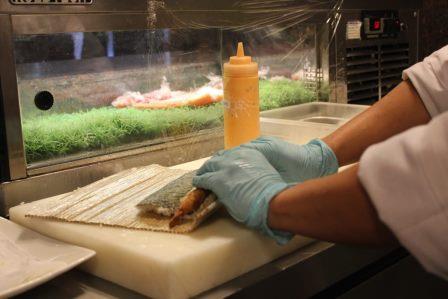Sushi is the most famous Japanese dish outside of Japan, and one of the most popular dishes among the Japanese themselves. In Japan, sushi is usually enjoyed on special occasions, such as a celebration.
I really wanted to eat Sushi because I had heard it in a lot of movies and it is my mom’s favorite dish. She would always say it tastes very nice. Initially, I thought that Sushi was cooked and was eaten hot. It is only when my mother told me that sushi is essentially raw fish – and this made me a little nervous.
But when I was invited to Oko, the beautiful Pan-Asian restaurant at The Lalit Chandigarh, all of my misconceptions were cleared. I was greeted by Chef Akub, who was very sweet and patient in educating me about the intricacies of sushi.
What is Sushi?
Before he began with the demonstration, Chef Akub informed me that in the Japanese language, ‘Su’ means vinegar and ‘shi’ means rice. So sushi is essentially fish wrapped in rice that has been mixed with vinegar and a little sugar. The famed iconic Japanese Sushi is the art of combining boiled rice marinated with rice vinegar and seafood or vegetable on top or rolled within.
There are also some non-seafood sushi ingredients. These include:
- Egg (tamago)
- Cucumber (kappa)
- Avocado
I was excited to enter the kitchen at the Oko where there were different types of fish, a bowl of rice, paper-like sheets of thin black seaweed and a special bamboo mat (called makisu) on which the sushi would be rolled.

I was totally enamored by Chef Akub’s dexterous fingers as he handled that long and sharp knife to cut almost paper-thin slices of salmon for making the first type of sushi. Type? What type? Sushi is sushi no?
Types of Sushi
Chef Akub then went on to explain the different varieties of sushi. These are:
- Uramaki
This is a medium-sized cylindrical piece with two or more fillings and was developed as a result of the creation of the California roll, as a method originally meant to hide the nori. Uramaki differs from other makimonos because the rice is on the outside and the nori inside. The filling is in the center surrounded by nori, then a layer of rice and an outer coating of tempura powder or even sesame – but this is optional. It can be made with different fillings, such as tuna, crab meat, avocado, mayonnaise, cucumber or carrots.
- Norimaki
Maki is essentially sushi that is rolled inside out. So the black seaweed is the innermost layer and it is covered with tempura prawn and 120 grams of vinegar-sugared rice. I was also told that these are not so popular in Japan – but more popular outside Japan. The push and pull technique that the chef used to roll the sushi and the measured pieces that he cut with the knife, without actually measuring them were so fascinating.
- Nigiri
Nigiri is basically small rice balls – the sticky rice is shaped into an oval shape. And then they are covered with a thin layer of fish (Chef Akub used salmon) or shellfish (we used a piece of crab) on top. I was also told that tuna, shrimp, eel, squid, octopus and fried egg are also used to make nigiri.

Difference between Sushi & Sashimi
Chef Akub also informed me that Sushi is sometimes confused with, and is totally different from Sashimi. Sashimi is also a Japanese dish – but it is made of thinly sliced raw fish, or occasionally meat, and an optional serving of rice. Sashimi is just the meat, served without other ingredients. Sushi also uses rice and other ingredients, such as vegetables, which are all rolled up in a sheet or nori (seaweed) and sliced into pieces.
You’ll either see it as maki (which means roll), where the seaweed is on the outside, uramaki, where the seaweed is on the inside and rice is on the outside, or temaki, a cone-shaped piece of sushi that’s rolled by hand.
Nigiri is the dish that’s halfway in between. Nigiri is sashimi that’s served on a molded rectangle of rice.
Lastly, while most sashimi is raw fish, some sashimi is not raw and some sashimi is not fish. For example, unagi is cooked freshwater eel, and sashimi also encompasses other types of seafood, which you will see below
When Chef Akub had prepared a delectable spread of sushi for me, he also went on to demonstrate how to present it well – the art of plating it.
Sushi is always served with three side condiments – soy sauce (Japanese soy sauce is milder and tastier), wasabi (a green sauce made with horseradish – this was pungent, but I think I put too much of it on my sushi) and pickled ginger (I never knew ginger could be so tasty). I was stuffed to the gills with all the fish I had eaten!
The crispy freshness of raw ingredients presented with a burst of color and beautiful presentation was an experience I will never forget. I thanked Chef Akub for my first ever sushi experience and turning me into a believer in Sushi. I also promised I will be back soon. If you happen to travel to Chandigarh, do visit Oko at The Lalit.
In fact, Celebrate an Oriental Christmas at Oko with a Christmas Eve Dinner for the whole family.
On December 24 from 7:30 pm to 11:30 pm, partake in Chef Suriya’s delectable recipes and have a truly merry time!
Contact 8288033856/ 8288033894 or log on to https://www.thelalit.com/the-lalit-chandigarh/offers/ for special offers at the Oko!



